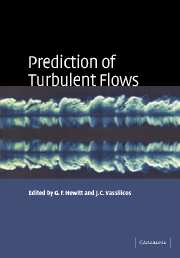Book contents
- Frontmatter
- Contents
- 1 Introduction
- 2 Developments in the understanding and modelling of turbulence
- 3 RANS modelling of turbulent flows affected by buoyancy or stratification
- 4 Turbulent flames
- 5 Boundary layers under strong distortion: an experimentalist's view
- 6 Turbulence simulation
- 7 Computational modelling of multi-phase flows
- 8 Guidelines and criteria for the use of turbulence models in complex flows
5 - Boundary layers under strong distortion: an experimentalist's view
Published online by Cambridge University Press: 12 August 2009
- Frontmatter
- Contents
- 1 Introduction
- 2 Developments in the understanding and modelling of turbulence
- 3 RANS modelling of turbulent flows affected by buoyancy or stratification
- 4 Turbulent flames
- 5 Boundary layers under strong distortion: an experimentalist's view
- 6 Turbulence simulation
- 7 Computational modelling of multi-phase flows
- 8 Guidelines and criteria for the use of turbulence models in complex flows
Summary
Abstract
The problems concerning the understanding and prediction of strongly-distorted turbulent boundary layers are reviewed. Some of the views expressed emanate from the Isaac Newton Institute (INI) programme on turbulence in 1999; others are an experimentalist's view of current modelling techniques and the requirements for future work. The purpose of this chapter is, first, to pinpoint research that has already been carried out in this area and, second, to highlight gaps in our knowledge where there is a need for specific experiments to enable the subsequent development of existing turbulence models. Attention is not restricted to Reynolds-averaged Navier–Stokes (RANS) solvers but also considers the problems regarding the modelling for large-eddy simulation (LES). The subject of this chapter is vast, and therefore ample use is made of existing reviews by authors who are experts in specific subject areas. These include ‘extra rates of strain’, changes in boundary conditions, as well as even more complex phenomena such as shock/boundary-layer interaction and boundary layers with a variety of embedded vortices. While we have many of the numerical tools required for design and prediction, it is clear that physical understanding of the dominant mechanisms is lacking and therefore our ability to predict them is also. As far as our existing knowledge is concerned, emphasis is placed on an empirical approach for reasons of pragmatism. Some ‘application challenges’ presented during the course of the INI programme on turbulence are addressed.
- Type
- Chapter
- Information
- Prediction of Turbulent Flows , pp. 163 - 206Publisher: Cambridge University PressPrint publication year: 2005



